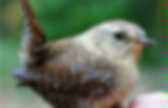

The Mammal Society helps track UK mammals. Osprey 'Lady' returns to Loch of the Lowes reserve. 29 March 2011Last updated at 15:03 The bird has returned to the nest after spending the winter in Africa An osprey thought to be the oldest breeding female ever recorded in the UK has returned to its nest at a wildlife reserve in Perthshire.
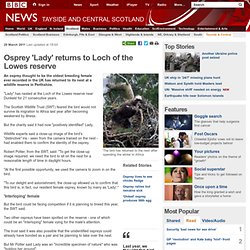
"Lady" has nested at the Loch of the Lowes reserve near Dunkeld for 21 consecutive years. The Scottish Wildlife Trust (SWT) feared the bird would not survive its migration to Africa last year after becoming weakened by illness. But the charity said it had now "positively identified" Lady. Idyllic new home for red squirrels on Tresco. Woodside Wildlife and Falconry Park - Home Page - Langworth, Lincoln, Lincolnshire. BBC One Programmes - Walk on the Wild Side. Identify wildflowers online. UK Moths. Wildlife Finder - European water vole facts, pictures & stunning videos.
Two Bank Voles (Myodes glareolus) - 400 miles apart! Johnny Kingdom's Wildlife Website. British Hedgehog Preservation Society BHPS. Hedgehog Mating Rituals - Attenborough - Life of Mammals - BBC. Wildlife Finder - Hedgehog facts, pictures & stunning videos. Welcome to Tiggywinkles Wildlife Hospital. Hedgehog rescue. Tiny hedgehogs are victims of climate change. Hedgehog Rescued from a McFlurry Carton. Endangered Birds at Animal Corner. Below is a list of endangered and threatened birds of the British Isles.

These particular bird species have become endangered or have declining populations within the British Isles and may become extinct in the future. The most serious threats to bird species are habitat loss, particularly conversion of diverse native forest into often single-species timber plantations and to birds colliding with fences erected to keep deer out of young plantations.
Other threats are because modern farming practices mean that nests and birds are destroyed by mowing or harvesting before breeding is finished. Some birds are declining due to overuse of pesticides and scrub clearance due to human overpopulation. Quiz: How Well Do You Know British Mammals? - Wildlife Gardener (UK) Author: Dr Gareth Evans - Updated: 3 June 2010| Comment When it comes to wildlife, most of our favourites are mammals – so it’s no accident that the WWF chose that panda – and as for the “ooh” factor, these cute and furry chaps have it in spades!

It’s hardly surprising then, that some of Britain’s most popular wild creatures can be found amongst the 65 or so mammal species that are either considered native to these shores or long-established residents. From bats to badgers and from deer to dormice, whether you like your wildlife big or small, whatever your favourites, there’s bound to be a healthy smattering of mammals in your own personal top ten. So, are you an expert on British mammals? 1.
A) 7b) 17c) 170 2. A) In spring, red squirrels turn grey.b) Grey squirrels can often have a definite reddish tinge to their fur.c) Red squirrels can also often be a grey colour. 3. 4. Scottish Wildcat Association, conserving Scotland's critically endangered wild felines. Puffin. Puffins are any of three small species of alcids (auks) in the bird genus Fratercula with a brightly coloured beak during the breeding season.
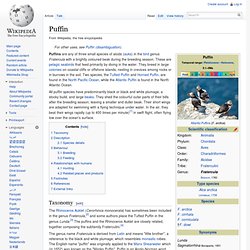
These are pelagic seabirds that feed primarily by diving in the water. They breed in large colonies on coastal cliffs or offshore islands, nesting in crevices among rocks or in burrows in the soil. Two species, the Tufted Puffin and Horned Puffin, are found in the North Pacific Ocean, while the Atlantic Puffin is found in the North Atlantic Ocean. All puffin species have predominantly black or black and white plumage, a stocky build, and large beaks. They shed the colourful outer parts of their bills after the breeding season, leaving a smaller and duller beak.
Badgerland - The Definitive On-Line Guide to Badgers in the UK. Wildlife Finder - Dormouse facts, pictures & stunning videos. Wildlife Finder - Hedgerows facts, pictures & stunning videos. Wildlife Finder - Field vole facts, pictures & stunning videos. UK Safari - A site for anyone interested in the wildlife of Britain. Wild About Britain. Brown Hares - Lepus capensis. Scientific name: Lepus capensis Size: Grows to approx 55cm.
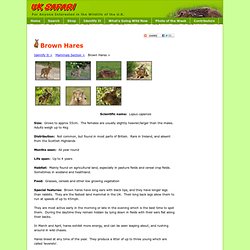
The females are usually slightly heavier/larger than the males. Adults weigh up to 4kg Distribution: Not common, but found in most parts of Britain. Rare in Ireland, and absent from the Scottish Highlands Months seen: All year round Life span: Up to 4 years Habitat: Mainly found on agricultural land, especially in pasture fields and cereal crop fields. Food: Grasses, cereals and other low growing vegetation Special features: Brown hares have long ears with black tips, and they have longer legs than rabbits. They are most active early in the morning or late in the evening which is the best time to spot them. In March and April, hares exhibit more energy, and can be seen leaping about, and rushing around in wild chases. Hares breed at any time of the year. Related Pages. British Garden Birds.
BBC Two - Springwatch. BBC iPlayer - The Animal's Guide to Britain: Grassland Animals. BBC iPlayer - The Animal's Guide to Britain: Woodland Animals. Rain 'almost apocalyptic' for wildlife, says National Trust. 15 July 2012Last updated at 20:02 ET Puffins have drowned in their burrows after relentless wet weather The UK's recent rainy weather has been "almost apocalyptic" for some wildlife in 2012, the National Trust has said.
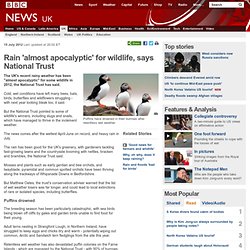
Cold, wet conditions have left many bees, bats, birds, butterflies and wildflowers struggling - with next year looking bleak too, it said. But the National Trust pointed to some of wildlife's winners, including slugs and snails, which have managed to thrive in the inclement weather. The news comes after the wettest April-June on record, and heavy rain in July. The rain has been good for the UK's greenery, with gardeners tackling fast-growing lawns and the countryside booming with nettles, bracken and brambles, the National Trust said.
Mosses and plants such as early gentian and bee orchids, and twayblade, pyramidal and common spotted orchids have been thriving along the trackways of Whipsnade Downs in Bedfordshire. Puffins drowned. British Wildlife Publishing: UK Wildlife. UK Safari - A site for anyone interested in the wildlife of Britain. Wildlife Finder - Mole facts, pictures & stunning videos. Wild Life Skills #6 - Mole watching. Encyclopedia of Life.